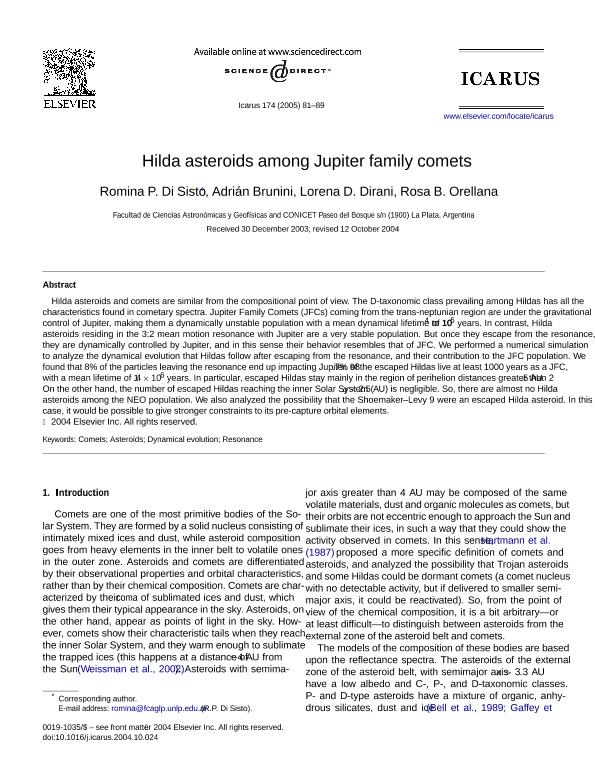Mostrar el registro sencillo del ítem
dc.contributor.author
Di Sisto, Romina Paula

dc.contributor.author
Brunini, Adrian

dc.contributor.author
Dirani, Lorena Daniela

dc.contributor.author
Orellana, Rosa Beatriz

dc.date.available
2018-03-07T14:01:07Z
dc.date.issued
2005-12
dc.identifier.citation
Di Sisto, Romina Paula; Brunini, Adrian; Dirani, Lorena Daniela; Orellana, Rosa Beatriz; Hilda Asteroids among the Jupiter Family Comets population; Academic Press Inc Elsevier Science; Icarus; 174; 12-2005; 81-89
dc.identifier.issn
0019-1035
dc.identifier.uri
http://hdl.handle.net/11336/38105
dc.description.abstract
Hilda asteroids and comets are similar from the compositional point of view. The D-taxonomic class prevailing among Hildas has all the characteristics found in cometary spectra. Jupiter Family Comets (JFCs) coming from the trans-neptunian region are under the gravitational control of Jupiter, making them a dynamically unstable population with a mean dynamical lifetime of 104 to 105 years. In contrast, Hilda asteroids residing in the 3:2 mean motion resonance with Jupiter are a very stable population. But once they escape from the resonance, they are dynamically controlled by Jupiter, and in this sense their behavior resembles that of JFC. We performed a numerical simulation to analyze the dynamical evolution that Hildas follow after escaping from the resonance, and their contribution to the JFC population. We found that 8% of the particles leaving the resonance end up impacting Jupiter. 98.7% of the escaped Hildas live at least 1000 years as a JFC, with a mean lifetime of 1.4 × 106 years. In particular, escaped Hildas stay mainly in the region of perihelion distances greater than 2.5 AU. On the other hand, the number of escaped Hildas reaching the inner Solar System (q < 2.5 AU) is negligible. So, there are almost no Hilda asteroids among the NEO population. We also analyzed the possibility that the Shoemaker–Levy 9 were an escaped Hilda asteroid. In this case, it would be possible to give stronger constraints to its pre-capture orbital elements.
dc.format
application/pdf
dc.language.iso
eng
dc.publisher
Academic Press Inc Elsevier Science

dc.rights
info:eu-repo/semantics/openAccess
dc.rights.uri
https://creativecommons.org/licenses/by-nc-sa/2.5/ar/
dc.subject
Comets
dc.subject
Asteroids
dc.subject
Dynamical Evolution
dc.subject
Resonance
dc.subject.classification
Astronomía

dc.subject.classification
Ciencias Físicas

dc.subject.classification
CIENCIAS NATURALES Y EXACTAS

dc.title
Hilda Asteroids among the Jupiter Family Comets population
dc.type
info:eu-repo/semantics/article
dc.type
info:ar-repo/semantics/artículo
dc.type
info:eu-repo/semantics/publishedVersion
dc.date.updated
2018-03-06T15:11:02Z
dc.journal.volume
174
dc.journal.pagination
81-89
dc.journal.pais
Países Bajos

dc.journal.ciudad
Amsterdam
dc.description.fil
Fil: Di Sisto, Romina Paula. Universidad Nacional de la Plata. Facultad de Ciencias Astronómicas y Geofísicas; Argentina
dc.description.fil
Fil: Brunini, Adrian. Universidad Nacional de la Plata. Facultad de Ciencias Astronómicas y Geofísicas; Argentina
dc.description.fil
Fil: Dirani, Lorena Daniela. Universidad Nacional de la Plata. Facultad de Ciencias Astronómicas y Geofísicas; Argentina
dc.description.fil
Fil: Orellana, Rosa Beatriz. Universidad Nacional de la Plata. Facultad de Ciencias Astronómicas y Geofísicas; Argentina
dc.journal.title
Icarus

dc.relation.alternativeid
info:eu-repo/semantics/altIdentifier/doi/http://dx.doi.org/10.1016/j.icarus.2004.10.024
dc.relation.alternativeid
info:eu-repo/semantics/altIdentifier/url/http://www.sciencedirect.com/science/article/pii/S001910350400363X
Archivos asociados
